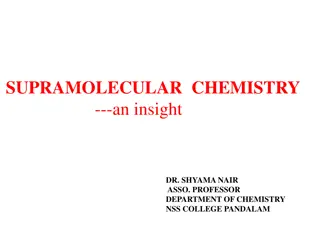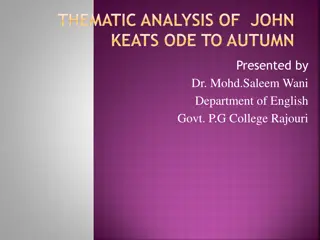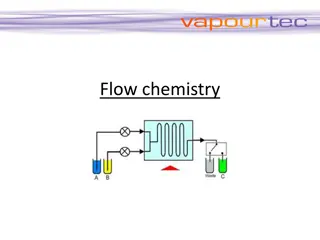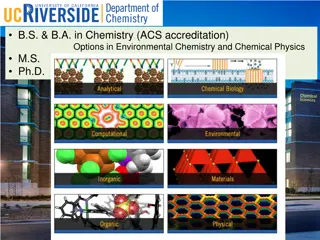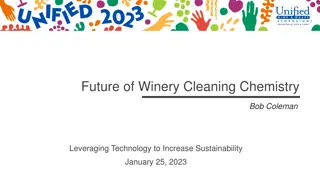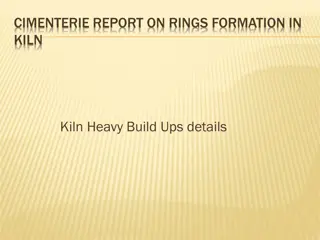
Metallic Carbonyls: Preparation and Properties
Learn about the preparation methods and properties of metallic carbonyls, including mononuclear and polynuclear carbonyls. Explore direct synthesis and carbonylation processes with examples of transition metals like Fe, Ni, and Co. Discover the role of CO as a carbonylating and reducing agent in the formation of different metallic carbonyls.
Download Presentation

Please find below an Image/Link to download the presentation.
The content on the website is provided AS IS for your information and personal use only. It may not be sold, licensed, or shared on other websites without obtaining consent from the author. If you encounter any issues during the download, it is possible that the publisher has removed the file from their server.
You are allowed to download the files provided on this website for personal or commercial use, subject to the condition that they are used lawfully. All files are the property of their respective owners.
The content on the website is provided AS IS for your information and personal use only. It may not be sold, licensed, or shared on other websites without obtaining consent from the author.
E N D
Presentation Transcript
PREPARATION AND PROPERTIES OF METALLIC CARBONYLS Dr. Mohd Saleem Department of Chemistry Introduction The electronic configuration of CO molecule shows that both carbon and oxygen atoms has a lone pair of electron. Carbon atom can donate its electron pair to a transition metal atom to form OC M coordinate bond. Hence the compounds form by combination of CO molecules, with transition metals are known as metallic carbonyls. Since the electrons supplied solely by CO molecule in the formation of OC M bond,
Carbonyls have been classified on the basis of the number of metal atoms present in the carbonyl i. Mononuclear (or monomeric) carbonyl: Which is having only one metal atom per molecule and having type M(CO)y. e.g. V(CO)6, Cr(CO)6 etc. Polynuclear carbonyl: Which contain two or more metal atoms per molecule having type ii. Mx(CO)y. how ever some authors call carbonyls containing two metal atoms are called bridged carbonyl and which containing more than two metal atoms are called polynuclear carbonyls which may be homonuclear e.g. Fe3(CO)12 or hetereonucear [e.g. MnCo(CO)9, MnRe(CO)10].
GENERAL METHODS OF PREPARATION (i) Direct Synthesis (ii)By carbonylating metallic salts with CO in presence of educing agent (iii)Preparation of Mo(CO)6 and W(CO)6 from Fe(CO)5 (iv)Preparation of Fe2(CO)9, and Os2(CO)9 from Fe(CO)5
Direct Synthesis Only Ni(CO)4 and Fe(CO)5 and Co2(CO)8 are normally obtained by the action of CO on the finely divided metal at suitable tempreture and pressure. o 200 C, 100 atm press. 5CO + Fe(CO) Fe 5 R.T., 100 atm press. 4CO + Ni Ni(CO) 4 o 200 C, 100 atm press. 8CO + 2Co Co 2CO) 8
By carbonylating metallic salts with CO in presence of reducing agent Metallic carbonyls are obtained when salts like RuI3,CrCl3, VCl3, CoS, Co(CO)3, CoI2 etc. are treated with CO in presence of suitable reducing agent like Mg, Ag, Cu, Na, H2, AlLiH4 etc. o 115 C, 70 atm press. 5CO + + Cr(CO) + + CrCl LiAlH LiCl AlCl 3 4 6 3 o 175 250 C, atm press. 10CO + + 2Ru(CO) + RuI 6Ag 6AgI 3 5 o 25 C, 210 atm press. + Mn (CO) 2MgI + + 2 MnI 10CO diethyl (in 2Mg 2 2 5 2 ether) 200 C, o 200 atm press. 8CO + + + 2 CoS 4Cu Co (CO) 2Cu S 2 8 2 200 C, o 200 atm press. 10CO + + 2Fe(CO) + 2 FeS 2Cu Cu S 5 2 200 C, o 200 atm press. 8CO + + + 2Co I 4Cu Co (CO) 4CuI 2 2 8
200 C, o 200 atm press. 5CO + + Fe(CO) + 2Fe I 2Cu Cu I 2 5 2 2 250 C, o 120 -200 300 - atm press. 8CO + + + + 2 CoCO 2H Co (CO) 2CO 2 H O 3 2 2 8 2 2 o 160 C, 300 atm press. + + C3Mg(acac) + 2 Cr(acac) 12 CO Mg 3 2Cr(CO) 3 2 6 (inpyridin 6CO 5 + e) 5Na + diglyme) (in Mo(CO) + MoCl 5NaCl 6 Sometimes CO acts as a carbonylating and reducing agent as under. o 25 0 C, 350 atm press. + Os(CO) + OsO CO 5 2O 5 5 2 + + Re O 10 CO Re (CO) 7O 2 7 2 10 2 V(CO)6 is prepared by the method represented by the following equation o 100 C, 150 atm press. + + V(CO) + VCl 6 CO Na 3NaCl 3 (indiglyme 6 acidificat ion by H PO ) 3 4
GENERAL PROPERTIES Physical properties Most carbonyls are volatile solids but Fe(CO)5, Ru(CO)5, Os(CO)5 and Ni(CO)4 are liquids at ordinary temperature and quite inflammable. Many of these decompose or melt at low temperature. They are soluble in organic solvents. Ni(CO)4 is insoluble in water but others react with it. All carbonyls, except V(CO)6, are diamagnetic substances. Metals with odd atomic number couple the odd electrons to form metal-metal bond. Probably the steric factor prevents V(CO)6 from dimerization. All carbonyls are thermodynamically unstable with respect to oxidation in air, but their rates vary widely. Co2(CO)8 reacts at ordinary temp. Fe2(CO)9 and Ni(CO)4 are also readily oxidized (their vapours forming explosive mixtures with air); M(CO)6, M = Cr, Mo, W react only when heated.
Chemical properties Substitution reaction CO groups can be replaced by monodentate ligands like isocynide (CNR), PR3, PCl3, py, CH3OH etc. e.g. Ni(CO)4 + 4CNR Ni(CNR) + 4CO Ni(CO)4 + 4PCl3 Ni(PCl3) + 4CO Fe(CO)5 + 2CNR Fe(CO)3(CNR)2 +2CO Mn2(CO)10 + PR3 2Mn(CO)4(PR3) + 2CO 2Fe2(CO)12 +3py Fe3(CO)9(py)3 + 3Fe(CO)5 2Fe2(CO)12 +3CH3OH Fe3(CO)9(CH3OH)3 + 3Fe(CO)5
Bidentate ligands like diars, o-phen, NO2 etc. replace at two or more CO group at a time. e.g. Mo(CO)6 + diars Mo(CO)4(diars) + 2CO Fe(CO)s + diars Fe(CO)3diars +2CO Ni(CO)4 + o-phen Ni(CO)2(o-phen)2 + 2 CO Ni(CO)4 + diars Ni(CO)2(diars) + 2 CO Cr (CO)6 + 2diars Cr(CO)2(diars)2 + 4CO Ni(CO)4 + 2NO2 Ni(NO2)2 + 4CO
(ii) Action of NaOH or Na metal Aqueous or alcoholic solution of NaOH reacts with Fe(CO)5 to form carbonylate anion, [HFe(CO)4]- [H Na 3NaOH + 0) (Fe = + + - 2 + -] Fe(CO) Fe (CO) Na CO + 3 H O 5 4 2 2 H-atom in [H+Fe2-(CO)4]- ion is acidic which means that Fe-atom in this ion is in -2 oxidation state. Na-metal in liquid NH3 converts Fe2(CO)9, Co2(CO)8, Fe3(CO)12, Cr(CO)6, Mn2(CO)10 etc in to carbonylate anions and in these carbonyls are reduced. Na 2 4Na + 0) (Fe = Na 2 2Na + 0) (Co = + - 2 - 2 Fe (CO) [Fe (CO) ] + CO 2 9 2 4 + - - Co (CO) [Co (CO) ] 2 8 4 + - - Fe (CO) = + 3Na 3 Na [Fe (CO) ] 3 12 4 (Fe 0) + - 2 - 2 Cr(CO) + 6 2Na Na [Cr (CO) ] + CO 2 5 = (Cr 0) + - - Mn (CO) = + 2Na 2 Na [Mn (CO) ] 2 10 5 (Mn 0)
(iii) Carbonyl react with halogens to form carbonyl halides Fe(CO)5 + X2 Fe(CO)4X2 + CO Mo(CO)6 + Cl2 Mo(CO)4Cl2 + 2CO Mn2(CO)10 + X2 (X=Br, I) 2Mn(CO)5X Co2(CO)8 and Ni(CO)4 both get decomposed into metallic halides and CO when treated with halogens. e.g. Co2(CO)8 + 2X2 2CoX2 + 8CO Ni(CO)4 + Br2 NiBr2 + 4CO
(iv) Action of NO Many carbonyl react with nitric oxide to form metal carbonyl nitrosyls. e.g Fe(CO)5 + 2 NO Fe(CO)2(NO)2 + 3CO 3Fe2(CO)9 +4NO 2Fe(CO)2(NO)2 +Fe2(CO)5 + Fe3(CO)12 + 6CO Fe3(CO)12 + 6NO 3Fe(CO)2(NO)2 + 6CO Co2(CO)8 + 2NO 3Co(CO)3(NO) + 2CO Moist NO gives a blue coloured compound, Ni(NO)(OH) with Ni(CO)4while dry NO gives a blue solution of the composition, Ni(NO)(NO2) 2Ni(CO)4 + 2NO + 2H2O 2Ni(NO)(OH) + 8CO + H2 Ni(CO)4 + 4NO Ni(NO)(NO2) + 4CO + N2O
(v) Action of H2 When Mn2(CO)10 and Co2(CO)8 react with H2, they are reduced to carbonyl hydride, Mn(CO)5H and Co(CO)4H respectively. 200 atm. press. + + - 0 Mn (CO) H 2[Mn (CO) H ] 2 10 2 5 o 165 C, 200 atm. press. + + - 0 Co (CO) H 2[Co (CO) H ] 2 8 2 4
(vi) Action of Heat Different carbonyls give different product when heated shown bellow. o 250 C + Fe(CO) Fe 5CO 5 o 70 cool C, + 3Fe (CO) 3Fe(CO) Fe (CO) 2 9 5 3 12 (in toluen e) o 140 cool C, + Fe (CO) 3Fe 12CO 3 12 o 50 atmosphere inert C, + 2Co (CO) Co (CO) 4CO 2 8 4 12 o 180 C + Ni(CO) Ni 4CO 4 o 50 C + 3Fe (CO) 2Fe (CO) CO 3 2 9 3 12 (in toluen e)
Structure and nature of M-CO bonding in carbonyls The lone paired of electron on carbon atom would expected to form strong -dative bond due to electron density remain to the carbon nucleus. Formation of dative -bonds It is form as a result of overlapping of empty hybrid orbital of metal atom with the filled hybrid orbital on carbon atom of CO molecule and form M CO -bonds. i.e. formation of Ni CO -bonds in Ni(CO)4 takes place by the overlap between empty sp3 hybrid orbital on Ni and filled sp orbital on carbon atom of CO molecule. Other three Ni CO bonds are formed in the same manner. In the type of M(CO)5 and M(CO)6 carbonyls dsp3 and d2sp3 hybrid orbital are used for M CO -bonds. In this bond formation, metal atom acts as electron acceptor, while CO acts as electron donor.
Formation of dative -bonds This bond is formed as a result of overlapping of filled d orbitals or hybrid dp orbitals of metal atom with low-lying empty p -orbitals on CO molecule. i.e. M CO i.e. Ni CO -bond in Ni(CO)4 form by overlap between filled dz2 or dx2-y2 on Ni atom and empty * molecular orbital on CO molecule. M CO -bond form by overlapping with filled dxy, dyz or dxz orbital of M with empty * molecular orbital on CO molecule. Out of six CO, three are linked by M CO -bond and remaining three is linked by M CO and M CO -bond. As M-CO donation increases, the M-C bond becomes stronger and the C=O bond becomes weaker. Thus the multiple bonding would result in shorter M-C bonds and longer C-O bonds as compared M-C single bonds and C=O triple bonds respectively. The C-O bond lengths are rather insensitive to bond order, the M-C bonds show appreciable shortening consistent with bonding concept.



